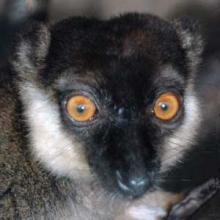Eulemur cinereiceps is a medium-sized lemur with a head-body length of 39–40 cm, a tail length of 50–55 cm, an overall length of 89–95 cm, and a body weight of around 2.0–2.5 kg (Tattersall, 1982; Bradley et al., 1997; Johnson et al., 2005). This species is sexually dichromatic. In males, the dorsal coat is gray-brown, the tail and lower limbs slightly darker, and a dark brown stripe often runs along the spine. The ventral coat is a paler gray, as are the head and face. A dark gray crown turns lighter on the neck and shoulders. Both the cheeks and beard are white or light cream and bushy. Coloration of the males of this lemur is very similar to that of E. collaris, except that male E. cinereiceps have white beards rather than the rufous beards of E. collaris. Female E. cinereiceps are virtually indistinguishable from female E. collaris, the coat being reddish-brown above with lighter underparts. Their faces are uniformly slate-gray, with a short, reddish-brown beard that matches the coat color and is not bushy like that of the male (S. E. Johnson, pers. comm.). Genetic analyses show that these two taxa are distinct species (Djletati et al., 1997; Wyner et al., 1999b), as do field studies in apparent hybrid zones of E. rufifrons and E. cinereiceps (Sterling and Ramarason, 1996; Johnson and Wyner, 2000). Lemur (recte Eulemur) cinereiceps was described by Grandidier and Milne-Edwards in 1890, and is illustrated in their monumental work on Madagascar. The specimen upon which this species was based was a female, hence the Latin name (“gray head”). Unfortunately, although the Grandidier plates are excellent, text was produced only for the Indriidae, not for the remaining lemurs. Schwarz (1931) assigned the cinereiceps name to two Paris museum specimens from two localities in southeastern Madagascar, Farafangana and Solohy. This animal remained in obscurity for a long time, until it was resurrected by Groves (1974). Unaware of this, Rumpler (1975) described the white-collared brown lemur as Lemur albocollaris, and this name, later changed to Eulemur albocollaris, has been used for this species for the better part of the last 35 years (including in the last two editions of this field guide). However, a recent survey by Johnson et al. (2008) found that the animals living in Farafangana and Solohy are in fact what has usually been referred to as Eulemur albocollaris. This evidence, added to that of Schwarz (1931), seems to confirm that Grandidier and Milne-Edwards’ cinereiceps was based on females of the species named albocollaris by Rumpler (1975). Johnson et al. (2008) have reviewed the literature, and conclude that, according to Art. 23.9.1 of the International Code of Zoological Nomenclature, the senior synonym cannot be rejected in this instance, and that the correct name of the white-collared brown lemur is indeed Eulemur cinereiceps (C. P. Groves, pers. comm.). Consequently, we have adopted this name for the brown lemur species from this part of southeastern Madagascar, and no longer use the name E. albocollaris.
